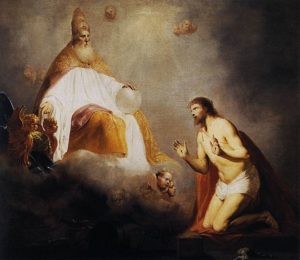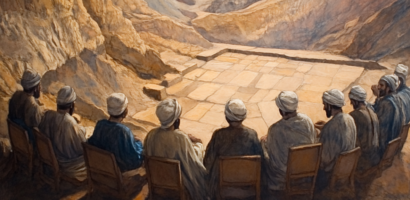Behold, he is coming with the clouds, and every eye will see him, even those who pierced him…
As John states who the principle heavenly parties are that commission him to write and deliver the letter of Revelation, he is interrupted by two seemingly unexpected benedictions. One of them is in vs. 5b-6 and the next one is in vs. 7, where we see two Biblical prophecies invoked – Dan. 7:13-14 and Zech. 12:10:
“I saw in the night visions, and behold, with the clouds of heaven there came one like a son of man, and he came to the Ancient of Days and was presented before him. And to him was given dominion and glory and a kingdom, that all peoples, nations, and languages should serve him; his dominion is an everlasting dominion, which shall not pass away, and his kingdom one that shall not be destroyed.”
“And I will pour out on the house of David and the inhabitants of Jerusalem a spirit of grace and pleas for mercy, so that, when they look on me, on him whom they have pierced, they shall mourn for him, as one mourns for an only child, and weep bitterly over him, as one weeps over a firstborn.”
While the various Son of Man traditions based upon Daniel 7 were already known in Jewish apocalyptic tradition at the time of the composition of Revelation, the fusion of these two concepts (triumphant and tragic) was not. Moreover, while New Testament documents like the book of Revelation, mostly operate within an already pre-existing set of Jewish concepts, its genius and uniqueness oftentimes can be seen in the merger of previously unmixed Jewish concepts such as Logos of God (Memra of God) and Incarnation in John 1:14, and Son of God (Ben Elohim) and Son of Man (Ben Adam/Bar Enosh) in John 5:25-28. Even the Talmudic sages of a later period understood the triumphant and tragic prophecies about Messiah to predict two Messiahs, the Son of David and the Son of Joseph.
“Our Rabbis taught, The Holy One, blessed be He, will say to the Messiah, the son of David (May he reveal himself speedily in our days!), Ask of me anything, and I will give it to thee, as it is said, I will tell of the decree etc. this day have I begotten thee, ask of me and I will give the nations for thy inheritance (Ps. 2:7-8). But when he will see that the Messiah the son of Joseph is slain, he will say to Him, Lord of the Universe, I ask of Thee only the gift of life. As to life, He would answer him, Your father David has already prophesied this concerning you, as it is said, He asked life of thee, thou gavest it him, [even length of days for ever and ever – Ps 21:5].” (Babylonian Talmud, Sukkah 52a) (1)
Another passage from the Talmud, which reveals the rabbinic understanding of the merit-based reward of the Messiah coming to redeem Israel, shows an alternative attempt to harmonize the triumphant, cloud riding Messiah with the tragic, meek and suffering servant, riding upon a donkey. It proposes that the prophecies describe two potential Messiah trajectories which will depend on the condition of the covenant people.
“…it is written, in its time [will the Messiah come], whilst it is also written, I [the Lord] will hasten it! (Is 60:22) if they are worthy, I will hasten it: if not, [he will come] at the due time… it is written, And behold, one like the son of man came with the clouds of heaven (Dan 7:13) whilst [elsewhere] it is written, [behold, thy king cometh unto thee…] lowly, and riding upon an ass! (Zech 9:7). If they are meritorious, [he will come] with the clouds of heaven if not, lowly and riding upon an ass. King Shapur [I] said to Samuel, Ye maintain that the Messiah will come upon an ass: I will rather send him a white horse of mine. 37 He replied, Have you a hundred-hued steed(2)?” (Babylonian Talmud, Sanhedrin 98a)
Revelation takes these two seemingly independent and hard to reconcile concepts of Messiah as one, a triumphant victor; and one, a suffering servant of God; and combines them into one person, the Messiah who came, suffered, and is yet to claim his full glory.
… and all tribes of the earth will wail on account of him. Even so. Amen.
What is interesting is that in the Christian religious imagination, all peoples of the world here are mourning the piercing of the Christ of God; but given the fact that this is a Zecharaic allusion (see above), doubtless the tribes of Israel are in fact in view. Earth/Land (Arets) is standard designation not of all the earth in Hebrew, but of the Land of Israel in particular.
8 “I am the Alpha and the Omega,” says the Lord God, “who is and who was and who is to come, the Almighty.”
Even though it is customary to speak of Jesus as the Alpha and the Omega, as best we can tell, there is a distinction between the glorified Jesus and the Alpha and Omega Himself in the text itself, especially in Rev. 1:4 (see the discussion above).
The technical term of the Alpha and the Omega appears 3 times in Revelation (Rev. 1:8, Rev. 21:1-8, Rev. 22:6-15). In all three cases, it cannot be immediately interpreted as Jesus (though the authors of this book have no problem in affirming Jesus’ divinity as it was portrayed in other parts of New Testament). The only case where Jesus is more explicitly connected to this title is the later example from Rev. 22:6-15, where immediately following statements about Alpha and Omega (in the first person), there is a statement by Jesus (also in the first person): “I, Jesus, have sent my angel to testify to you about these things for the churches. I am the root and the descendant of David, the bright morning star.” (Rev. 22:16) Although, we must keep in mind that in the book of revelation there is polyphony of voices that the center stage from one another as the story unfolds.
While it is possible to harmonize the Alpha and Omega in Rev.22:13 with Jesus in Rev.22:16 we think that given Alpha and Omega’s identity with “he who is and who was and who is to come” in Rev. 1:8 and Jesus’ clear distinction from that very person in Rev. 1:4, the position that equates Jesus with Alpha and Omega in a direct linear fashion is simply not feasible. The book of Revelation purposely paints a different, more complicated picture.
The marvelous grandeur of Jesus Christ as described in Revelation, and yet his distinction from the Lord God Almighty in the book, may be best seen against the backdrop of other Jewish Apocalyptic Son of Man traditions, where the divinity of both the Son of Man and the Ancient of Days/Head of Days is explicit and yet not harmonized (1 Enoch 48 and 69).
[divider]
(2) Horse of many colors









I find it compeling to bring forth Eieh Asher Eieh in relation to the alpha & omega. More importantly, I think this linkage really parallels two world vissions, that of ancient Israel in the person of Moses an Egiptian trained prince confronting an eternal God and the vission of John, probably the apostle, maybe not, but nevertheless a Greek-Latin almost surely legally trained mind confronting the testimony of Jesus, the Ressurrected Jewish Messiah.
Two mindsets. One and the same God.